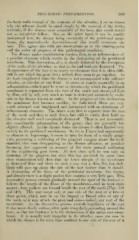Page 959 - My FlipBook
P. 959
PHAGEDENIC PERICEMENTITIS. 969
tlie bony walls instead of the contents of the alveolns, I see no reason
why the ailment should be cured simply by the removal of the teeth
;
certainly, if the disease were essentially of the bone, this result Avoidd
not so invariably follow. But, on the other hand, it can be readih-
understood how, the disease being essentially of the peridental mem-
brane, the removal—the destruction—of this would terminate the
case. This agrees also with my observations as to the starting-point
and the order of progress of this pathological condition.
The disease under consideration consists, then, in an inflammation of
a peculiar character wliich results in the destruction of the peridental
membrane. This destruction, also, is closely followed by the absorption
of the walls of the alveolus; so that in the end both are destroyed. The
disappearance of the two is so nearly synchronous that it is often diffi-
cult to say which has gone first ; indeed, they seem to go together. In
its least complicated form the disease is not accompanied with salivary
calculus, or calculus of any kind. It seems to consist essentially in an
inflammation—which may be acute or chronic— by which the peridental
membrane is separated from the root of the tooth and destroyed fibre
by fibre, cell by cell, very much as bone is destroyed molecule by mole-
cule in the disease known as caries. In the progress of this destruction
the membrane first becomes swollen ; its individual fibres are very
much enlarged and lengthened and intermixed with an abundance of
inflammatory elements. The fibres seem first to separate from the root
of the tooth and then to melt down, but still to retain their hold on
the alveolar wall until completely destroyed. There is not necessarily
any considerable inflammation of the gums ; they are generally but
slightly aflected. In the chronic forms the disease is often limited very
strictly to the peridental membranes. So fiir as I have had opportunity
to observe its beginnings, it seems to take the form of a simple gingi-
vitis, presenting a reddening of the gingival margins about the teeth
attacked, this soon disappearing as the disease advances, or possibly
becoming less apparent on account of the more general reddening
of the neighboring gum tissue. At first there will be seen only an
irritation of the gingivae, but after this has persisted for some time
close examination will show^ that the lo^ver margin of the membrane
is destroyed here and there in such a way that a thin, flat, but dull,
blade ^vill pass up along the side of the root farther than it should.
A destruction of the tissue of the peridental membrane has begun,
and already there is a slight j^ocket that contains a very little pus. This
destructive process extends gradually toward the apex of the root— /. e.
follows the length of the fibres of the membrane—and in most cases
narrow, deep pockets are formed beside the root of the tooth (Figs. 518
and 519). This may occur only at one side of the root or at two or
three points, which may be on the lingual or buccal sides of any of
the teeth, or it may attack the proximal sides—indeed, any part of the
mend^rane. As tlie destructive process extends lengthwise of the root
it also more slowly widens, often quite irregularly, extending around the
root ; so that the tendency is to the destruction of the entire root-mem-
brane. It is usually very irregular in its attacks ; cases are seen in
which the disease is for some time confined to one side of the root of a


